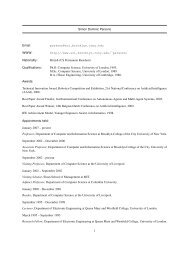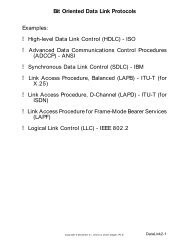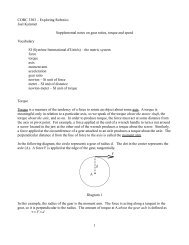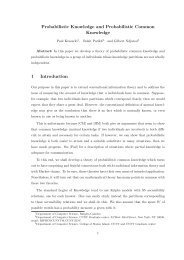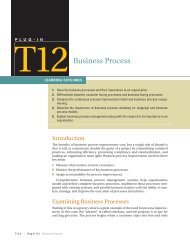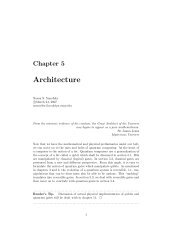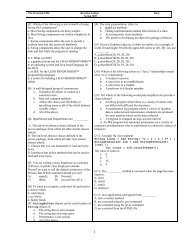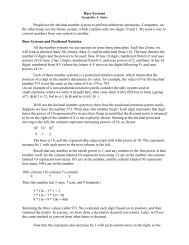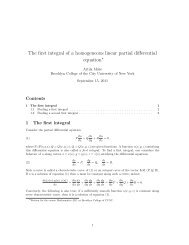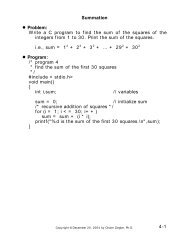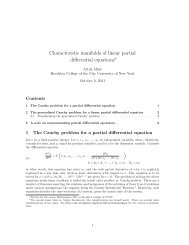*302 Greig and Others v Insole and Others 1977 G. No. 22461977 J ...
*302 Greig and Others v Insole and Others 1977 G. No. 22461977 J ...
*302 Greig and Others v Insole and Others 1977 G. No. 22461977 J ...
Create successful ePaper yourself
Turn your PDF publications into a flip-book with our unique Google optimized e-Paper software.
[1978] 1 W.L.R. 302 Page 54<br />
[1978] 1 W.L.R. 302 [1978] 3 All E.R. 449 (1978) 122 S.J. 162 [1978] 1 W.L.R. 302 [1978] 3 All E.R. 449 (1978)<br />
122 S.J. 162<br />
(Cite as: [1978] 1 W.L.R. 302)<br />
to suffice to carry a resolution but “subject to confirmation<br />
by the Cricket Council.” Under<br />
rule 7 , any appeal from a decision<br />
from a number of specified sub-committees<br />
of the TCCB has to be referred not to the TCCB but<br />
“to the Cricket Council.” The realisation of the<br />
TCCB that it is indeed responsible to the Cricket<br />
Council in the exercise of its functions is well illustrated<br />
by the fact that the important decisions of<br />
policy taken by it at its meeting of July 15, <strong>1977</strong>,<br />
were all made subject to the Cricket Council's supporting<br />
the TCCB's recommendations. If the Cricket<br />
Council had reversed the recommendations, the<br />
TCCB would have had no authority whatever to act<br />
on them, save by the unanimous consent of all its<br />
members.<br />
In these circumstances, in answer to question<br />
(G) above, I hold that the TCCB is not an<br />
“employers' association” within the statutory definition<br />
on the narrow, but to my mind conclusive,<br />
ground that, in exercising its functions, it is responsible<br />
not to its members but to an entirely different<br />
body, the Cricket Council. It has not been<br />
submitted, *362 <strong>and</strong> I think could<br />
not be submitted on the facts, that the Cricket<br />
Council is itself an “employers' association.”<br />
The right to work": ques-<br />
XVIII “<br />
tion (H) above<br />
The grounds on which I have decided that<br />
neither of the defendant bodies is an “employers'<br />
association” within the meaning of the Act of 1974<br />
have made it unnecessary to deal with a number of<br />
broader questions that were canvassed in argument<br />
in relation to that Act. One very important such<br />
question is whether it can be properly claimed that<br />
the “principal purposes of an organisation” include<br />
the “regulation of relations between employers …<br />
<strong>and</strong> workers” for the purpose of section 28<br />
(2) (a) , merely because one of its principal<br />
purposes includes the ordaining of rules setting out<br />
the qualifications which a person must possess if he<br />
is to enter or remain in a specified field of employment.<br />
The defendants have submitted that the answer<br />
to this question is in the affirmative <strong>and</strong> in this<br />
context pointed to the definition of a “worker” in<br />
section 30 (1) of the Act of 1974<br />
as including a person who works “or seeks to work”<br />
as therein mentioned.<br />
If this construction of the Act of 1974 be<br />
correct, it would appear to have the most far reaching<br />
consequences. On this interpretation, it would<br />
seem, it would be open to a number of employers<br />
deliberately to associate themselves for the purpose<br />
of agreeing that specified persons or categories of<br />
persons should be disqualified from seeking or remaining<br />
in employment with any of them. The association<br />
having been founded, it would seem that<br />
they could then claim that it constituted an<br />
“employers' association,” <strong>and</strong> that, being such, it<br />
enjoyed the immunities conferred by<br />
sections 3 <strong>and</strong> 14 of the Act of<br />
1974, so that its rules, however unreasonable, could<br />
not be attacked as being in restraint of trade <strong>and</strong> it<br />
would enjoy general immunity from liability in tort.<br />
There are at least two possible answers to<br />
this, at least to me, rather unattractive submission<br />
on the part of the defendants. First, it may be that,<br />
as the plaintiffs submit, the phrase “regulation of<br />
relations between employers … <strong>and</strong> workers” in the<br />
context of section 28 (2) (a) is apt<br />
only to include the regulation of relations during<br />
the subsistence of the period of employment <strong>and</strong><br />
thus cannot extend to rules which are designed to<br />
prevent employment from ever arising.<br />
Secondly, it is possible that, even if a hypothetical<br />
association formed for the purposes to<br />
which I have referred constituted an “employers'<br />
association” within the statutory definition, its rules<br />
could still be successfully attacked, not so much on<br />
the grounds that they were in “restraint of trade,” as<br />
on the broader grounds that they were contrary to<br />
public policy as preventing persons' right to work.<br />
A number of dicta of members of the<br />
Court of Appeal in Nagle v. Feilden [1966] 2 Q.B.<br />
© 2011 Thomson Reuters.



